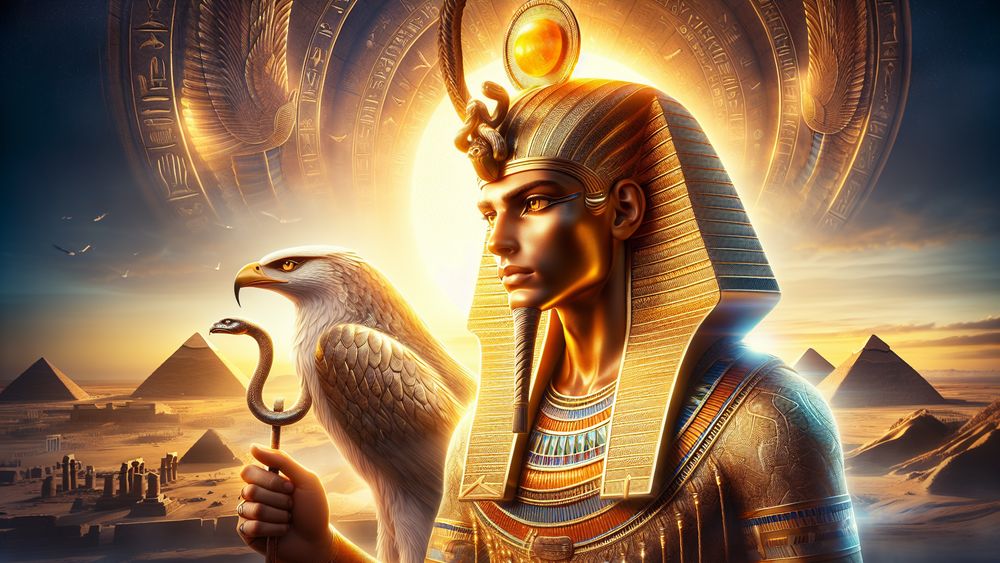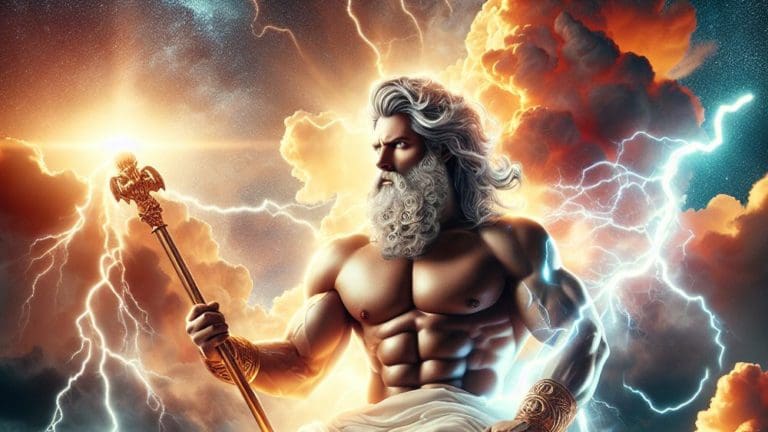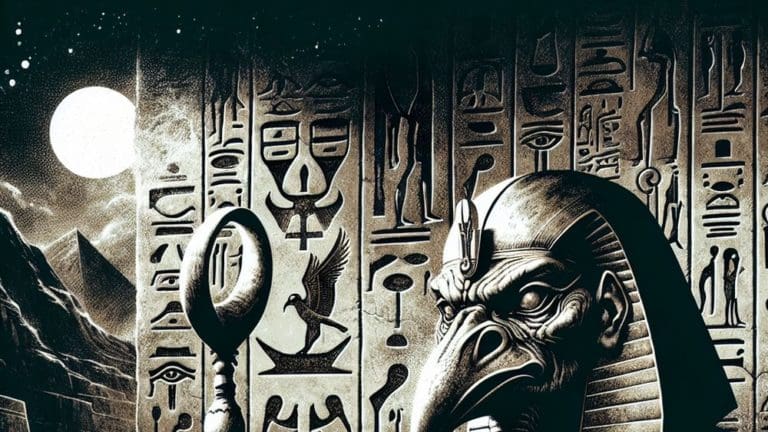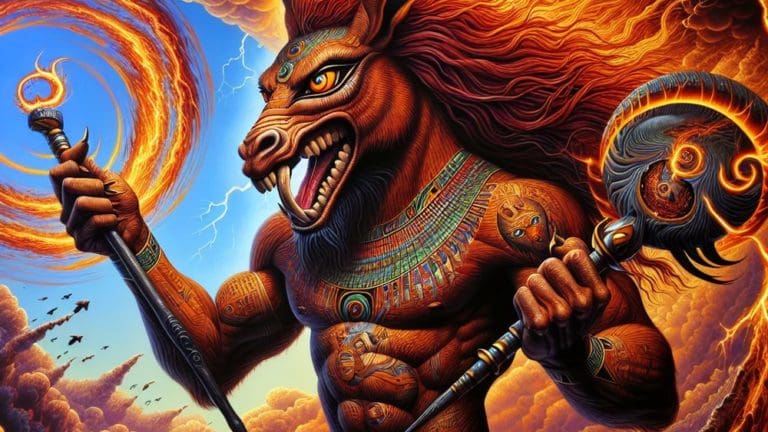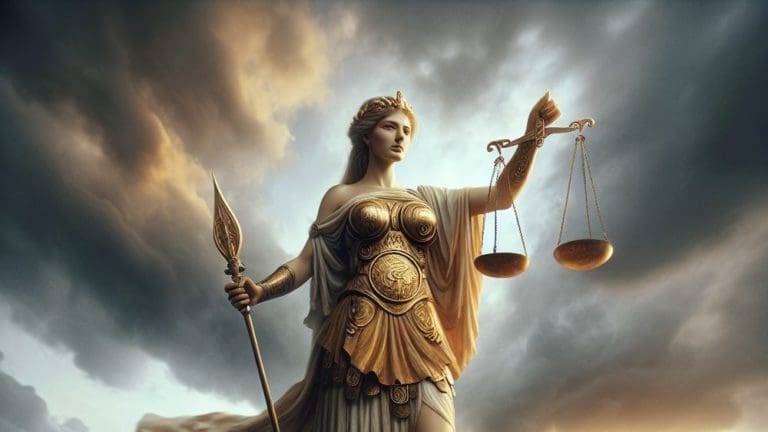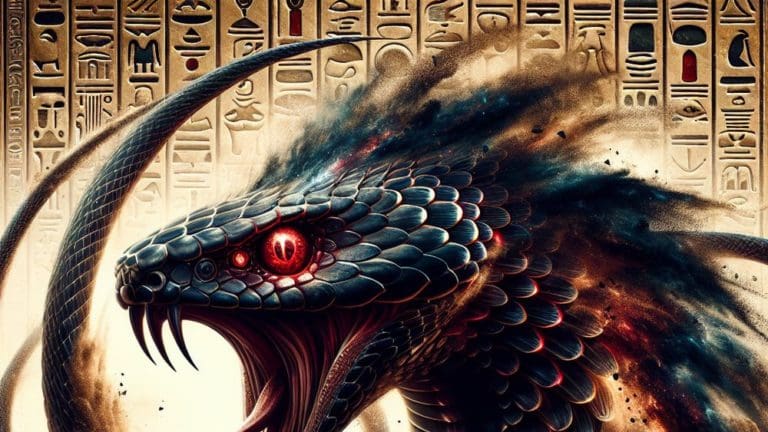Ancient Egyptian Deity Ra: The God Of The Sun
In the heart of ancient Egypt, Ra shines bright. He’s the sun god, a top-tier deity. His story and roots? Deeply stitched into Egypt’s cultural and spiritual quilt. Ra isn’t your everyday god. He’s the creation guy, the universe’s keeper. His symbols, like the sun disk and the falcon, pop up everywhere in Egyptian art. They remind people of his might and presence.
Key Points:
- Ra is the sun god in ancient Egyptian mythology.
- Ra is the creator and keeper of the universe.
- Ra’s symbols include the sun disk and the falcon, which are prevalent in Egyptian art.
- Ra’s influence extended to governance and culture in ancient Egypt.
- Ra’s worship involved rituals, offerings, and temples dedicated to him.
- Ra’s legacy persists in modern times through literature, movies, and ongoing Egyptology.
- Ra’s family ties and relationships with other gods played a crucial role in ancient Egyptian beliefs and practices.
Worship? Big for Ra. His followers went all out with rituals and offerings. Temples for him were everywhere, acting as hotspots for his praise. But Ra’s touch goes further, into how Egypt ran and its culture. Kings leaned on his divine clout to back up their power. Fast forward to now, and Ra’s still a star.
His myths and worship give us a clear view into how ancient Egyptians lived and what they held sacred.
The Origins and History of Ra
Diving into Ra’s backstory and his place in history really opens up a world of wonder. We’re heading into a space where the tales and facts about him come alive. So, let’s get the ball rolling and unpack the chapters of his epic saga.
Who is Ra and Why is He Important?
In the heart of ancient Egyptian lore, Ra shines bright. He’s the sun god, you see. A top-tier deity. His story starts with the world itself, which he spoke into being. That’s right, simply by saying its name. This act places Ra at the very center of life, warmth, and growth for everything that lives and breathes.
Imagine him sailing across the sky each day, a cycle that mirrors life, death, and rebirth for us all. This makes him a key player in keeping the universe in check and the seasons turning. Ra’s influence? Vast. He was the king of all gods and the pharaoh’s divine backer which meant his word was law in both heaven and earth.
This respect for Ra wove its way through every part of Egyptian culture and faith. It showed up in buildings designed to catch the sun’s rays and in ceremonies meant to win his favor.
- Falcon head and dominion over the sky show Ra’s power up high.
- The Eye of Ra, which is another name for the goddess Wadjet, acts as his protector and power projector.
- Sun temples, especially the one at Heliopolis, were where people gathered to honor him.
- Solar boats, found in sacred spots, symbolize his daily and nightly trips, which reflect the never-ending loop of life and afterlife.
So, Ra wasn’t simply another god on the roster. He was the very essence of life and order in ancient Egypt, making him absolutely crucial to understand when we talk about this time and place.

Ra, the sun god in ancient Egyptian lore, held immense power and influence over life and order, central to the culture and beliefs of that time and place.
Ra’s Place in Egyptian Mythology and His Family
Ra, the sun god, sits at the heart of ancient Egyptian myths. He’s like the glue that keeps the divine family tree together. Ra’s family ties stretch far and wide, connecting a bunch of gods and goddesses through birth and stories. He’s got kids and grandkids, which include some pretty famous names like Hathor and Sekhmet. These connections aren’t random. They tell us how the ancient Egyptians saw the world.
Combining Ra with Amun to make Amun-Ra? That was a huge move. It showed everyone that two major religious centers could come together, which was a bit like saying, “Hey, we’re all on the same team here.” When it comes to dealing with other gods, Ra’s relationships are a mix of friendly and, well, less so.
He battles Apophis every night to keep chaos at bay and takes a nightly cruise through the underworld which is a pretty bold move for a sun god. These tales and the roles that gods play in them are key for getting why ancient Egyptians did what they did when it came to praying and building temples. It’s all about keeping the world balanced and making sure good times roll for everyone.
| Relationship | Deity | Role/Significance |
|---|---|---|
| Child | Hathor | Goddess of love and beauty, often seen as Ra’s daughter |
| Child | Sekhmet | Goddess of war and healing, Ra sent her as his eye to sort out humans when needed |
| Creation | Shu and Tefnut | The first gods Ra made, standing for air and moisture which sounds pretty essential if you ask me |
| Enemy | Apophis (Apep) | The chaos serpent that Ra fights every night because someone has to do it |
| Fusion | Amun-Ra | When Ra and Amun joined forces, it was like the ultimate power move in ancient Egyptian religion |
Symbols and Representations of Ra
Shifting gears, we now zoom in on how Ra looks and what stands for him in the minds and hearts of those in ancient Egypt. It’s like when you see a logo and instantly know which brand it is. Ra has his own set of logos. They tell his story without using words.
Iconography and Sacred Symbols of Ra
When you think about Ra, two symbols pop up right away: the sun disk and the falcon. The sun disk, which sometimes has a cobra around it or comes with wings, tells us Ra is the boss of the sun and all the good, life-bringing energy it gives us. You see this symbol everywhere in ancient Egyptian art.
It’s on temple walls, fancy clothes for royalty, and even small charms people wore for good luck. It’s a big sign that Ra’s power and care for life were central for everyone back then. Then there’s the falcon. This bird, especially the kind called the peregrine falcon, looks a lot like the sun disk when it opens its wings wide.
This made folks see the falcon as a piece of the sky itself and a guardian for the pharaoh, who was often thought of as Ra in human form. So, these symbols weren’t simply for show. They were key pieces of ancient Egyptian culture and religion, loaded with meanings and ways for people to feel close to the divine.
Ra’s symbols, the sun disk and the falcon, held immense significance in ancient Egyptian culture and religion, connecting people to the divine through their powerful and meaningful representations.
The Sun Boat and Its Mythological Significance
Every night, the story goes, Ra takes a trip through the underworld. He does this in his sun boat. This trip is no ordinary one. It’s a symbol for the sun setting and then rising again the next day. Imagine Ra steering through dark waters, facing off against Apophis, a nasty serpent that represents all that’s bad and chaotic.
He wins this fight so that the sun can shine once more when morning comes. This tale is huge for the ancient Egyptians. It talks about life and death, and the never-ending fight between good and bad. Plus, it’s all about rebirth and how everything starts fresh each day.

- Temple walls and tombs show the sun boat a lot. This tells us how key it was for both religious and funeral reasons.
- Priests had daily tasks to keep Ra safe on his trip. They used spells and gave offerings to help him beat Apophis.
- The boat was often said to be made of papyrus. This ties it back to the Nile and Egypt’s natural cycles.
- Sometimes, other gods joined Ra on his trip. They helped him fight chaos and keep everything in balance.
Worship and Cult of Ra
So, we’ve dived into Ra’s world, right? We’ve seen his stories and how big of a role he plays. Now, let’s shift gears and see how people back then showed their love and respect for him. It’s kind of like when you admire someone so much that you start doing things that show your appreciation. Ancient Egyptians were no different when it came to Ra.
The Temples and Centers of Worship for Ra
Ra’s followers gathered in special places that were all about him and the sun above. Heliopolis stood out, literally meaning where the sun’s city is. It was where people thought Ra popped up for the first time, marking the start of everything. This place had a special stone, the Benben, which was super central in their celebrations and stories about Ra.
Then, there’s Karnak Temple in Thebes. When Amun and Ra became a team, this spot got even more attention. It’s huge! With tall pillars and giant stone spikes reaching for the sky, trying to touch the sun Ra ruled. These buildings weren’t simply for show. They had a job. They connected people with Ra.

Every design detail and the way they were set up had one goal: to make this connection stronger. They lined them up so when the sun rose and set, it did so in a way that felt like Ra was right there with them. And when the light hit certain spots at the right time, it was like magic, making everyone feel closer to Ra.
So, these places were more than buildings. They were a bridge between the earth and the sky, where humans and their sun god could meet. It was all about keeping that bond strong and making sure Ra was happy and shining bright up there.
The special places dedicated to Ra and the sun were designed to strengthen the connection between humans and their god, Ra, through architectural details and alignments with the sun’s movements.
Rituals and Offerings to Ra
When it comes to honoring Ra, the sun god, ancient Egyptians pull out all the stops. They start their day with songs and prayers at dawn. It’s their way of saying hello to Ra as he kicks off his daily sky trip. Temples for Ra are everywhere, and they’re busy places. Here, people bring gifts like bread and beer, and even little statues.

These aren’t random presents; they’re carefully chosen to keep Ra strong for his daily battles and night-time underworld adventures. And when the calendar hits a solstice or equinox, it’s party time. These solar festivals are huge, with everyone joining in. There are parades where folks carry Ra’s symbols through the streets, and there’s lots of singing.
It’s all about keeping the world balanced and in harmony, which is a pretty big job.
- Songs and prayers sync with the sunrise.
- Gifts for Ra mix practical and symbolic items, feeding and honoring him.
- Solar festivals draw crowds, celebrating with parades and music.
- Parades make Ra’s presence felt, with symbols and statues carried for all to see.
This mix of daily rituals and special celebrations keeps everyone connected to Ra and the cosmic order. It’s simple yet powerful, blending everyday life with the divine.
Ra’s Influence Beyond Religion
The story of Ra doesn’t end at temple doors. It weavers through everyday life and the halls of power in ancient Egypt. We see his touch in art, in the way people ruled, and even in how they saw the world around them. Now, we’re heading into a space where Ra shines outside the strict boundaries of worship. His legacy, it’s everywhere. Let’s take that path and see where it leads, especially into today’s world and how it still feels his presence.
Ra in Ancient Egyptian Culture and Governance
In ancient Egypt, Ra shines bright. He’s the sun god, after all. Pharaohs, the top bosses, get to say they’re Ra’s kids. That’s a pretty big claim. It means they’re almost like gods walking around. People see them and think, “Wow, that’s a bit of Ra right there.” This idea makes the pharaohs super special. They get to make the rules and everyone’s okay with it because, well, they’re kind of divine.
Temples for Ra pop up everywhere. These aren’t your average buildings. They’re massive and majestic, places where you can really feel Ra’s power. The biggest and most impressive ones even have Ra’s name on them. It’s like he’s saying, “I’m here, and I’m watching over you.” This setup keeps everything running smoothly. The pharaohs rule, the people follow, and Ra’s in everything, making sure the world stays balanced and orderly.
It’s a neat system that keeps ancient Egypt ticking for ages.

The Legacy of Ra in Modern Times
Ra’s story, it’s everywhere today. You see, books and movies love to bring him and his world right back to life. It’s like he never left. Egyptology keeps digging up the past, and with every shovel of dirt, they find something that makes us go “wow.” This isn’t old news. It’s very much alive and kicking.
People can’t get enough of ancient Egypt and Ra. They put him in stories and on the screen. And the experts? They’re always finding new bits and pieces that tell us more about how folks back then thought and lived.
- Books like “The Kane Chronicles”? They make Ra and his myths part of today’s adventures.
- Movies? “Gods of Egypt” puts Ra front and center, making sure we remember who’s boss.
- Egyptology doesn’t sit still. New discoveries about Ra and his people pop up, grabbing headlines and sparking curiosity.
- Tombs and temples for Ra keep coming out of the sands, each one a new chapter in a very old story.
It’s simple. Ra’s legacy is strong. It bridges the past and present, making sure we don’t forget where we come from. And that’s pretty amazing.
Ra’s legacy remains strong, connecting the past with the present and emphasizing the importance of remembering our origins.
Pantheon of All the Egyptian Mythology Gods
So, we’ve got this big family of gods and goddesses in ancient Egypt. They’re everywhere. In the sky, the Nile, and even in the afterlife. Ra takes his boat across the sky every day and then does a night shift in the underworld. Isis? She’s all about magic and looking after moms and kids.
These gods and their stories are like threads in a massive web that connects everything in ancient Egypt. From the very top where the pharaohs sit, right down to everyday folks. This web influences how people act, what they believe, and even how they see the world around them. For those wanting to dive into the details of each god, there’s plenty out there. Stories that show how complex and colorful this pantheon really is.
FAQs
1. Who was Ra and why was he so crucial to ancient Egyptians?
Ra shines bright in the hearts of ancient Egyptians. He’s their sun god. Imagine, every day, he makes the sun rise and set. Life, food, and even the afterlife, Ra’s got it covered. He’s like the clockwork behind day and night and the force that brings the Nile’s floods. These floods are a biggie; they make the land fertile for crops.
2. How did Ra come into existence according to Egyptian mythology?
In the tales of old, Ra simply appears. He steps out from the chaos, which is Nun’s ancient waters. Imagine, if you will, a being so mighty that he thinks himself into existence. That’s Ra for you. He decides it’s time to be and so, he is. This act alone puts him at the heart of everything.
3. Can you explain the significance of Ra’s sun boat?
Ra’s sun boat plays a huge part in how the night and day cycle comes to be. It’s all about his trip every night through the underworld. This isn’t any ordinary trip. It’s a vital one for the sun to come back each morning, fresh and new. This story tells us that every night is a battle for dawn.
4. How is Ra worshipped today and does he still have followers?
In our times, Ra takes a different stage. He’s no longer at the center of grand temples nor the subject of daily prayers and offerings like before. Yet, his story and essence find a place in the hearts of some who tread the path of modern spiritual and neopagan traditions. They see him as a symbol, a piece of history to honor and remember.

